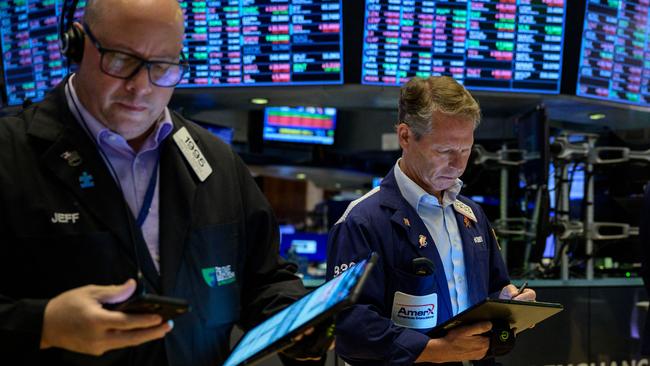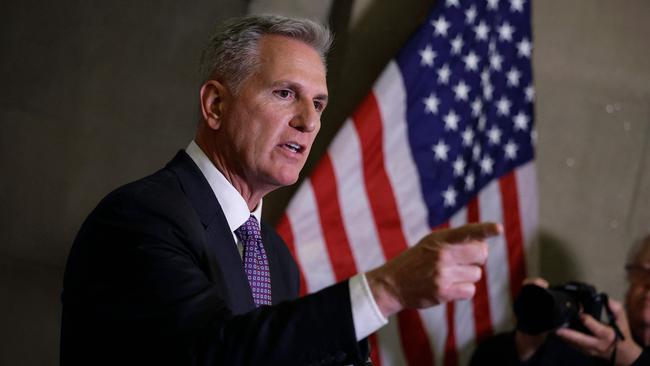US politicians’ stalemate over the debt ceiling is not the only worry
The outlook for US dollar liquidity and China’s economy are adding to the level of worry confronting investors.

US debt ceiling brinkmanship isn’t the only thing worrying investors at this point.
The talks are set to go down to the wire, as usual, but there’s still time for a deal to lift the debt limit before the early June deadline when the federal government runs out of money.
If President Joe Biden and House speaker Kevin McCarthy strike a deal by this weekend, House Republicans will have time to time to consider and pass it before the “x-date”.
Government furloughs would be bad for the economy and risk sentiment, but a default on debt payments isn’t much of a risk because US Treasuries have a right of first payment from taxation revenue, according to Morgans Financial chief economist Michael Knox.
“When the government shuts down, US taxation revenue is used to pay the money owed on US Treasury bonds first and US government employees second,” Knox says.
“This system has continued from 1791 until this day. This is why US Treasury bonds never default.”
First, it’s unclear if the Fed is done with rate rises despite chairman Jerome Powell hinting at a pause in June, and May FOMC minutes saying: “Many participants focused on the need to retain optionality after this meeting.” US personal consumption expenditures inflation data on Friday will show how much of a pause is feasible.
Second, there’s concern about the impact on US dollar liquidity of the Fed’s ongoing quantitative tightening and an inevitable rebuild of the US Treasury’s General Account – by issuing debt that may “crowd out” money that could otherwise flow to risk assets – after the debt ceiling is lifted.
Macquarie Australian equities strategist Matthew Brooks says once the debt ceiling is lifted, QT plus TGA rebuild will drain $US626bn ($958m) of US dollar liquidity up to September 30.
Equities have “looked through” economic risks this year with the support of extra cash as the TGA fell by $US500bn, but with only about $US68bn left, the debt ceiling will need to be lifted.
“After this, we project a $US626bn liquidity headwind by September from QT and TGA rebuild, partly offset by reverse repo funding one-third of the rebuild,” Brooks says.

“A cocktail of rising unemployment plus falling liquidity is likely to drive up volatility.”
There has been a tightening of lending standards by US banks since mid-to late 2022 – before the regional bank runs that occurred in March, prompting the Fed to temporarily boost liquidity.
Brooks says US lending standards are already at levels that typically lead to a US recession.
Data from Australia suggests the sharp rise in rates has also made it harder for domestic firms to obtain finance. In both cases, credit tightness is at levels normally seen in a recession.
Brooks says credit tightening hits the economy after six to 12 months. Given credit became very tight from the December quarter, we are getting closer to the point where it will hit inventory investment, capital goods orders, employment and consumer spending.
Credit tightening also hits the jobs market after nine to 12 months, so unemployment rates may start to lift in the September quarter.
The amount of tightening points to a 1-2 percentage point lift in unemployment rates by mid-2024, consistent with recessions. That would stop rate rises.
“We think the rise in equities since October 2023 is unsustainable without the support of rate cuts,” Brooks says. “We see tight credit driving earnings downgrades, especially for real estate and other cyclical sectors. Corporate spreads are also likely to rise in anticipation of delinquencies and charge-offs that typically result when credit is this tight.”
Third, China’s economy is not experiencing the sustained growth that was expected from its post-Covid reopening. Complicating matters is an ongoing new wave of the coronavirus.
That is hitting China’s sharemarket and exchange rate and commodity prices.
After rising as much as 11 per cent this year, the Shanghai Composite has fallen 7 per cent from its peak in early May, and has dived below a major chart level at 3220 points this week.
Iron ore prices have tumbled from around $US130 a tonne to $US96, with more falls expected.
Copper prices, after surging 22 per cent from mid-November to mid-January, have fallen back to the levels prevailing before China started to drop its Covid restrictions in early November.
“The overwhelmingly subdued macro environment casts a shadow over demand for many commodities in China,” said Citi strategists including global head of commodities research Ed Morse. “The market narrative counting on China’s consumption to recover to drive a broader rebound in global demand and prices, such as in oil, could turn out to be a mirage.
“The consistently subdued macro data suggests that the economy could be stuck and unable to achieve escape velocity out of the confidence rut for now.”
They see a lack of confidence among consumers and business as a key drag, with no quick fix.
“Government support could be triggered to prevent the economy from sputtering, but it is unlikely to provide a major boost to demand,” Citi strategists say.
China’s faltering recovery is hitting the Australian dollar and Aussie shares.
The dollar has fallen almost 2 per cent to a six-month low of US65.23c this week amid concern about China’s flagging recovery, a US dollar rebound on debt ceiling jitters, and selling against a sharply weaker Kiwi dollar after the RBNZ signalled it was done with rate increases.
The dollar looks to be breaking key chart levels that could trigger a fall to its 2022 low of US61.7c.
The S&P/ASX 200 share index has fallen 2 per cent this week with banks and miners hit.
Fourth, it’s that time of the year again. “Sell in May and go away” is a well-known phenomenon that often sees investors back away from the sharemarket over the northern hemisphere summer holidays. It traditionally starts with Memorial Day in the US – next Monday.
Australia also faces the usual tax-loss selling of laggard stocks before the financial year end.




To join the conversation, please log in. Don't have an account? Register
Join the conversation, you are commenting as Logout